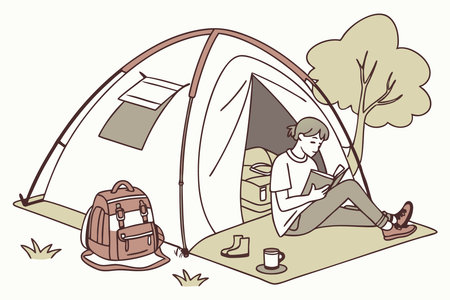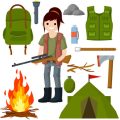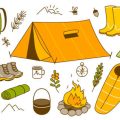1. The Basics of Combustion
To build a safe and effective campfire, its important to understand the science behind how fire works. At its core, combustion is a chemical reaction that produces heat and light. For this reaction to happen, three essential elements must be present: fuel, heat, and oxygen. This trio is often referred to as the “fire triangle.”
Understanding the Fire Triangle
The fire triangle helps explain how fires start, continue burning, and how they can be extinguished. Heres a simple breakdown of each component:
| Element | Description | Examples in Campfires |
|---|---|---|
| Fuel | Any material that can burn and feed the fire. | Dry wood, twigs, pine needles, charcoal |
| Heat | The energy needed to start and sustain combustion. | Matches, lighters, fire starters |
| Oxygen | A gas that reacts with fuel during combustion. | Air around the fire (contains about 21% oxygen) |
How Combustion Works at Your Campsite
When you strike a match or use a lighter to ignite kindling, youre adding heat to your fuel source. If theres enough oxygen in the air, the heat causes the fuel molecules to break apart and react with oxygen molecules. This reaction releases energy in the form of heat and light—what we see as flames.
Stages of Combustion
A typical campfire goes through three main stages:
- Ignition: Heat is applied to the fuel until it reaches its ignition temperature.
- Flaming Combustion: Active burning with visible flames; gases are released and burned.
- Smoldering Combustion: Lower-temperature burning once most volatile gases are gone; smoke increases.
Why This Matters for Safety
By understanding how these elements work together, campers can better control their fires. For example, if a fire gets too large or starts spreading, removing one part of the triangle—like dousing with water to remove heat or covering with dirt to block oxygen—can stop it. Knowing how combustion works also helps you maintain a steady flame for cooking or warmth without risking flare-ups or wildfires.
This foundational knowledge sets the stage for building smarter campfires that are not only efficient but also safe for everyone at the campsite.
2. Types of Campfire Fuels
When building a campfire, the type of fuel you choose plays a big role in how hot the fire burns, how long it lasts, and how much smoke it creates. Understanding these differences helps you build safer and more efficient fires during your camping trips. Let’s take a closer look at the three most common types of campfire fuels: hardwoods, softwoods, and manufactured fire starters.
Hardwoods
Hardwoods like oak, maple, hickory, and birch are dense and burn longer than other types of wood. Because of their density, they produce higher temperatures and create steady heat over time. This makes them great for cooking or keeping warm on chilly nights. However, they can be harder to light and may require kindling or a starter to get going.
Softwoods
Softwoods such as pine, fir, cedar, and spruce ignite quickly and are easy to find in many forests across the U.S. They’re great for starting fires but tend to burn faster and at lower temperatures compared to hardwoods. Softwoods also produce more smoke and can pop or spark due to resin content, which means you’ll want to keep an eye on them around tents or dry grass.
Manufactured Fire Starters
These include compressed sawdust bricks, wax-coated cubes, and even eco-friendly alternatives made from recycled materials. Manufactured fire starters are designed for convenience—they light easily and burn consistently. They don’t usually produce much smoke and can help get your fire going in damp conditions. However, they don’t last very long on their own and are best used with natural wood.
Fuel Comparison Table
| Fuel Type | Burn Temperature | Burn Time | Smoke Production | Best For |
|---|---|---|---|---|
| Hardwoods (e.g., Oak, Maple) | High (~1,100–1,500°F) | Long-lasting | Low | Cooking & Long Fires |
| Softwoods (e.g., Pine, Cedar) | Moderate (~800–1,200°F) | Shorter Burn | High (due to resins) | Starting Fires Quickly |
| Manufactured Fire Starters | Moderate (~1,000–1,300°F) | Short Burn Time Alone | Very Low | Damp Conditions & Easy Start |
Quick Tips:
- If youre planning a long evening around the fire or want consistent heat for cooking, go with hardwoods.
- Use softwoods to get the fire going fast but mix them with hardwoods for better longevity.
- Packing a few manufactured fire starters is a smart move in case your wood is damp or hard to light.
Selecting the right fuel not only makes your campfire experience more enjoyable but also helps reduce risks like flying embers or excessive smoke that could impact nearby campers or wildlife.

3. Managing Flame and Heat
Understanding how to manage the size and heat of your campfire is key to keeping your campsite safe. A controlled fire not only reduces the risk of wildfires but also makes cooking and warmth more efficient. The way you stack your wood plays a huge role in how the fire burns. Let’s break down some popular stacking methods and their impact on flame intensity.
Choosing the Right Stacking Method
The way you arrange your firewood affects airflow, burn rate, and heat output. Here are two common methods used by campers across the U.S.:
| Stacking Method | Description | Best For | Heat Output |
|---|---|---|---|
| Teepee | Wood is stacked upright in a cone shape with kindling in the center. | Quick ignition and short-term fires | High at first, then drops quickly |
| Log Cabin | Larger logs stacked in a square shape with space in the middle for kindling. | Longer burns and stable heat | Moderate and consistent |
Controlling Flame Size
A good rule of thumb is to keep your campfire flames under three feet high. Anything taller can become difficult to manage and increases the chance of sparks or embers escaping. If your fire starts getting too large:
- Add less fuel — smaller pieces burn slower and cooler.
- Avoid adding green or wet wood, which can pop and throw sparks.
- If needed, gently spread out the logs to reduce intensity.
Monitor Temperature Zones
The average campfire can reach temperatures up to 1,100°F (593°C) in its core. That’s hot enough to melt aluminum! Staying within safer temperature zones helps prevent accidents and damage to cooking gear. Use this simple guide:
| Zone | Description | Temperature Range (°F) |
|---|---|---|
| Main Flame/Core | The hottest part; where most combustion occurs. | 900–1,100°F |
| Sides of Fire Ring | Slightly cooler; good for roasting marshmallows or warming hands. | 400–600°F |
| Ash Bed/Coals | Sustained low heat; ideal for slow cooking like foil packets. | 300–500°F |
Tip: Use Your Hand (Safely!)
You can roughly gauge heat levels by holding your hand near the fire (without touching it): if you can hold it for 3–5 seconds before pulling away, its around 400–500°F — perfect for most cooking tasks.
Sensible stacking and heat control are essential parts of responsible camping. Knowing how to build and maintain a safe fire keeps everyone warm, fed, and out of harm’s way.
4. Common Campfire Hazards and How to Avoid Them
Campfires are a beloved part of the camping experience, but they also come with risks that every camper should understand. Knowing how combustion works helps us avoid common hazards and keep our campsites safe, especially in diverse American environments like forests, deserts, mountains, and coastal regions.
Flare-Ups
What it is: A sudden burst of flame caused by adding too much fuel at once or using flammable liquids like lighter fluid or gasoline.
Why it matters: Flare-ups can lead to burns or rapidly spreading fires.
How to Avoid Flare-Ups:
- Never use gasoline or lighter fluid to start or boost your campfire.
- Add small amounts of dry wood gradually to control flame size.
- Keep a bucket of water or sand nearby in case the fire grows too fast.
Wind-Spread Embers
What it is: Sparks or embers carried by wind that can ignite nearby grass, tents, or forest debris.
Why it matters: This is one of the leading causes of wildfires in dry areas like California and Arizona.
How to Avoid Wind-Spread Embers:
- Check local wind conditions before starting a fire.
- Avoid building fires during high wind advisories.
- Create a fire ring with rocks and clear at least a 10-foot area around the fire pit from any flammable materials.
Carbon Monoxide Buildup
What it is: A colorless, odorless gas released during incomplete combustion, especially when burning wood in enclosed spaces.
Why it matters: Breathing carbon monoxide can be deadly. It’s especially dangerous in tents or RVs.
How to Avoid Carbon Monoxide Exposure:
- Never burn anything inside your tent, even with ventilation.
- If using portable heaters or stoves inside an RV, ensure proper airflow and ventilation.
- Install a battery-powered carbon monoxide detector in your RV or camper van.
Quick Reference: Campfire Hazards and Solutions
| Hazard | Description | Avoidance Tips |
|---|---|---|
| Flare-Ups | Sudden large flames from excessive fuel | No accelerants; add fuel gradually; keep water nearby |
| Wind-Spread Embers | Sparks carried by wind igniting surroundings | Avoid windy conditions; clear area around fire; use fire ring |
| Carbon Monoxide Buildup | Toxic gas buildup from incomplete combustion | No fires inside tents; ventilate RVs; use CO detectors |
Stay Alert in Varying Terrains and Climates
The type of terrain youre camping in can greatly affect fire behavior. For example:
- Dessert areas (e.g., Nevada): Extremely dry conditions mean even a small spark can cause a wildfire. Use extra caution and follow local fire bans.
- Forested regions (e.g., Pacific Northwest): Dense vegetation may hide dry leaves and branches—clear these out before starting a fire.
- Mountainous zones (e.g., Colorado Rockies): Wind gusts can be unpredictable—build fires in sheltered spots away from slopes and ridges.
- Coastal campsites (e.g., California coast): Moist air may reduce fire risk slightly but don’t let your guard down. Coastal winds can still carry embers far.
Your safety—and the safety of others—depends on understanding how fire behaves in nature. With some knowledge and preparation, you can enjoy the warmth and joy of a campfire without putting yourself or the environment at risk.
5. Extinguishing Your Campfire Properly
Knowing how to put out a campfire the right way is just as important as building it safely. According to the U.S. Forest Service and Leave No Trace principles, most wildfires caused by humans are due to improperly extinguished campfires. That’s why understanding and using the “Drown-Stir-Feel” method is essential for every camper.
What Is the Drown-Stir-Feel Method?
This three-step process ensures your fire is completely out before you leave your campsite. Here’s how it works:
| Step | Description |
|---|---|
| Drown | Pour lots of water on the fire. Make sure all embers, not just the red ones, are fully soaked. Use enough water so that hissing sounds stop completely. |
| Stir | Use a stick or shovel to stir the ashes and embers. This helps expose any hidden hot spots and allows water to reach everything. |
| Feel | Carefully hover your hand over the ashes (without touching). If it still feels warm, repeat the Drown and Stir steps until everything is cool to the touch. |
Why This Matters
Even small embers can reignite hours later and start a wildfire, especially in dry conditions. By making sure your campfire is cold and dead-out, you’re protecting forests, wildlife, and future campers. It’s also part of being a responsible steward of public lands.
Quick Safety Tips Aligned with U.S. Guidelines
- Always have a shovel and a bucket of water nearby when you build a fire.
- Never leave a campfire unattended—not even for a minute.
- Do not bury your fire; buried embers can smolder and reignite later.
- Follow all local fire regulations and bans before starting any campfire.
The science behind combustion tells us that fires need heat, fuel, and oxygen to keep burning. The Drown-Stir-Feel method effectively removes all three—water cools the heat, breaks down fuel sources, and suffocates oxygen access. This simple technique ensures your fire won’t come back to life after you’ve packed up camp.

